
Review on 🔌 JideTech KVM Switch HDMI 2 Port Box 4K@60Hz, Audio Mic, HDMI Cables - HDMI 2.0, HDCP 2.2, HDR 10 Supported by Jesse Gray

Great value for a 4K HDMI option
I've been using KVM for years and had pretty low expectations of it, but it turned out to be very effective and a pleasant surprise. It works great and supports Windows, Linux, and ChromeOS without any issues. I can't comment on full 4k support, but I have UWFHD (2560 x 1080 resolution) and can confirm that this version of 4K HDMI supports it well, while my previous KVM (IOGear GCS62HU) which only supported 1080p had significant flare and other visual artifacts caused . on the display. The wired remote switch is a very useful feature of the KVM that allows you to access the button, but the KVM itself is hidden on the side. A subtle but surprisingly useful feature of the remote is that it also has a dim LED indicator on the remote to show which computer is currently active. After some checking and testing, there is no functional difference between the USB ports labeled mouse and keyboard. Any device works on any port. This is because it is a USB hub itself, see below for details. The big benefit of this is that plugging a separate USB hub into one (or both) of the ports will also work fine and all connected devices will switch between the computers. It's very useful to have separate speaker and mic jacks, and bundling them in the KVM cable is a nice touch, although that makes it a proprietary cable, so it's a compromise. A dedicated power supply is required only when not otherwise connected to a powered-on computer. It can be powered via any computer's USB connection and a dedicated adapter as a fallback. I did find a few flaws with this KVM, most of which are small parts: * The included KVM cables are proprietary and shorter than I would like. This actually works well for me since the setup is tight, but it would be nice to have longer (6ft / 2m) cables. * All connection cables use the very outdated microUSB connector. This isn't a huge problem since all connections are made to the device (KVM cable and wired remote cable), but can be an issue if the expected usage is frequent plugging and unplugging of cables. * It's a pretty cheap design feel. I put it in a side cabinet, which hopefully won't be a problem unless it's disturbed often. A wired remote helps a lot to make this smart. * No support for ScrollLock+ScrollLock key combination for switching computers. For two-device KVM, that's not a huge issue, but it would be good for muscle memory. Here, too, the wired remote control makes the problem much smaller. The cause probably lies in the implementation of a simple USB hub, KVM doesn't seem to interpret keystrokes (see below for details). * There is a low, constant hum when using a backlit keyboard. This has also been the case with other compact KVMs I've used and this is due to the open space and slight additional power consumption of the keyboard backlight. I have a keyboard that allows you to toggle the backlight and when you turn it off the hum stops. It seems that simply using a different power interface (e.g. IEC 60320) would solve this problem. Below are details of USB devices introduced in Linux. "OKLIC" devices appear to be designed to emulate USB devices, as they are always present on any connected computer, whether active or not. However, I couldn't get them to actually emit events, possibly due to the keyboard and mouse devices I have that seem to be connected separately to the KVM USB hub. When switching between computers, all connected USB devices are disconnected from the previous one and connected to the new selection. event3I: Bus=0003 Vendor=25a7 Product=6672 Version=0110N: Name="USB mouse OKLIC Mouse"H: Handler=mouse0 event4I: Bus=0003 Vendor=25a7 Product=6672 Version=0110N: Name= " USB Mouse OKLIC System Control"H: Handlers=kbd event5I: Bus=0003 Vendor=25a7 Product=6672 Version=0110N: Name="USB Mouse OKLIC Consumer Control"H: Handlers=kbd event6 Finally, as mentioned, USB's ports just seem straight forward. connected to an internal USB 2.0 hub. The hub presents itself to the system as a "Terminus Technology Inc." hub. on Linux (device ID 1a40:0101).
- Ease of use
- I'll add later
New products
Comments (0)
Top products in 🔀 KVM Switches
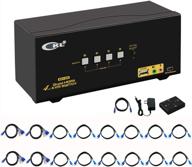
CKL Quad Monitor HDMI KVM Switch 4 Port 4K@30Hz with Cables - Extended and Mirrored Display Support for Windows, Linux, and Mac

11 Review
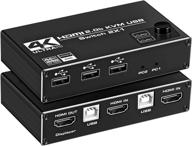
NEWCARE HDMI KVM Switch: 4K@60Hz, 2x1 HDMI2.0 Ports + 3X USB KVM Ports - Share 2 Computers on UHD Monitor, with Wireless Keyboard and Mouse Support - USB Disk, Printer, USB Camera Compatible

10 Review
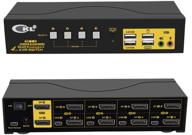
CKL 4 Port KVM Switch Dual Monitor DisplayPort 4K 60Hz: Unprecedented Multi-Computer Control with Audio, USB 2.0 HUBS, and DP 1.2

11 Review
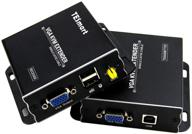
TESmart 1080P 60Hz USB VGA KVM Extender Over Cat5e Cat6 Ethernet Cable - Long Range 984ft/300m (Sender+Receiver)

10 Review
Another interesting products

Computer case be quiet! Pure Base 500 black

32 Review
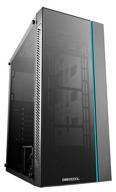
Computer case Deepcool Matrexx 55 black

55 Review
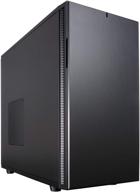
Fractal Design Define R5 - ATX Mid Tower Computer Case - High Airflow and Silent Optimized - Includes 2x Dynamix GP-14 140mm Silent Fans - Water-Cooling Ready - Black

43 Review
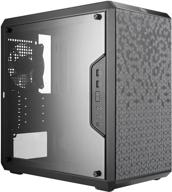
MasterBox Q300L Micro-ATX Tower with Magnetic Dust Filter, Acrylic Side Panel, Adjustable I/O & Ventilated Airflow, in Black

40 Review

